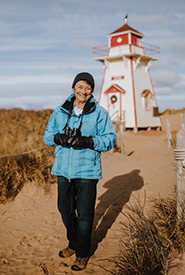Pieces of a puzzle

Diane Griffin (Photo by Jenna Rachelle)
Diane Griffin on conserving Prince Edward Island land, piece by piece
Senses can unlock memories, and the peppery smell of bayberries transports Diane Griffin to a rainy July day at Greenwich Beach on Prince Edward Island’s north shore.
Griffin was a university summer student, cataloguing the plant and animal species found around Greenwich Beach’s pristine sand dunes and wetlands. It was the start of a long career with a focus on conservation, but she was feeling like a drowned rat, writing on soggy paper while water ran off her raincoat into her rubber boots. Despite the weather, Greenwich Beach left an impression on her. “I remember thinking, ‘Oh my god, this area is so special,’” says Griffin. “I’d never seen anything like it.” Years later, she found herself taking the Lieutenant Governor
of Prince Edward Island on a nature tour of Greenwich Beach, now a part of PEI National Park.
Griffin recently joined the Nature Conservancy of Canada’s (NCC’s) Atlantic Region board of directors, bringing with her years of experience working in municipal, provincial and federal governments, as well as non-profits. She is a former senator for PEI, serving from 2016 to 2022. Her passion has always been land conservation, as a valuable legacy for the future. Growing up on a PEI dairy farm meant she had an early introduction to what grew in the area. “There were the weeds, but it was a great start,” laughs Griffin.
She joined her local 4H club and learned more, steering her toward an education in botany. After working in conservation in Alberta and PEI, Griffin served as PEI’s deputy minister for Fisheries and Environment. In 2008, she joined NCC as the PEI program director. She later was a town councillor for Stratford, PEI.
Canada’s most densely populated province, PEI has been extensively impacted by human activity. While working with NCC, Griffin looked for opportunities to conserve small parcels of land as part of a larger whole. Thinking about it like a jigsaw puzzle, Griffin says, “You know what the picture looks like on the cover. Getting those pieces in, that’s the work.” Griffin believes restoration strategies will become more important in returning land to its natural state and helping to connect those pieces.
Canada’s target of conserving 30 per cent of its lands and oceans by 2030 presents an opportunity for individual landowners to have an impactful role in conversation and supporting biodiversity, says Griffin. “They love the land they’ve got. Maybe it has wetlands, maybe it has a forest, or sand dunes. All these natural features that are of interest — and great wildlife habitat. They’re wanting to keep the land the way it is,” she says.
Working with an organization like NCC and donating their land ensures its protection, says Griffin. “I think a lot of people are interested in leaving something that will be a legacy for future generations,” she says. “And the natural lands they have is one way they can do that.”
Griffin acknowledges the crucial importance of conservation for biodiversity, while also noting the benefits for people’s physical and mental well-being. “Especially in an urban environment with traffic and noise, to get to an area where it’s green, the water is flowing and there are trails to walk, to slow down the pace of one’s life...the mental health aspect is huge,” says Griffin. While she has no intention of slowing down, Griffin looks back on a life spent promoting conservation, and a memory of where it all began.
“Every time I go to Greenwich, I still have to rub some bayberry leaves between my fingers for that smell.”
This story originally appeared in the winter 2023 issue of the Nature Conservancy of Canada Magazine. To learn more about how you can receive the magazine, click here.
Explore additional content from our winter issue here >




